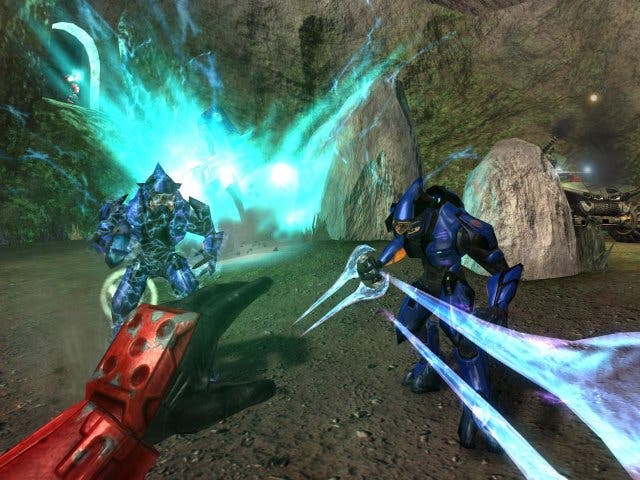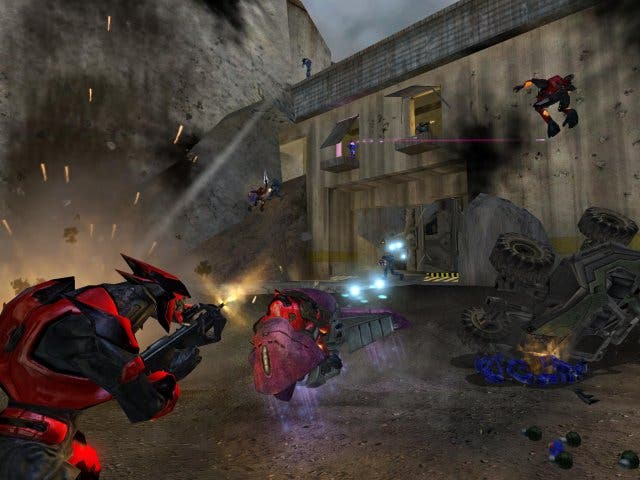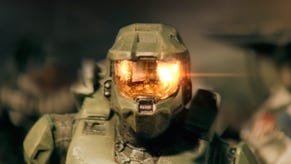Halo 2 Multiplayer
Time to fragging forget about the Campaign mode, okay?
Order yours now from Simply Games.
We wouldn't normally treat the single and multiplayer facets of a game as separate entities, but in the case of Halo 2 we didn't really have a whole lot of choice. Microsoft didn't even turn on the servers until the day after we posted our single player review (despite us having reviewed from a boxed copy), and, to be honest, we didn't have the chance to rally 12 TVs and 12 Xboxen (not to mention multiple copies of the game) to engage in a System Link marathon, and we didn't feel that this would adequately represent the 'real world' in any case. If you've read a review mentioning multiplayer, the chances are it's not much more than a mention: most Halo 2 reviews (including ours) were all frantically scribed in the few hours between receiving the game on Friday morning and Sunday evening when the worldwide embargo was lifted.
Fair play to Microsoft, though. For the first time in living memory a genuine worldwide embargo was set, giving publications such as this a genuine chance to compete on a level playing field - at least in terms of the publication date. Suffice to say that the same rules didn't apply to Doom III, Half-Life 2 or Grand Theft Auto: San Andreas, which have all been slapped with bizarrely unfair and unhelpful reviewing restrictions, which seem to serve no purpose other than to benefit the larger organisations. But rightly or wrongly, Microsoft didn't allow for multiplayer reviews, and inferred, in fact, that testing for the service was still ongoing right up until the last minute.
So, doing it "the old fashioned way" we grabbed a few hours here and there to find out for ourselves what the most important online console game ever had to offer above and beyond what you'd expect. The answer is probably not as simple as you were hoping; it's got almost everything you could want from the online aspect of a game, but yet still manages to omit industry standard features that conspire in some senses to render it less than satisfying.
Truth and reconciliation

It's almost too exhausting a prospect to trawl through the myriad of options available, to be frank, so before we weed out the interesting bits it's probably worth considering what we wanted that didn't make it into the final cut. Online co-op, for a start. With everything else that the game pulls off successfully, it's a real blow that Bungie couldn't allow players to tackle Campaign in co-op the same way they can offline. We're not technically minded enough to ponder too deeply why this proves to be such a technical hassle, but it's something that remains firmly on the wish list.
The other main omission is somewhat baffling given how well it worked in games like Project Gotham Racing 2, and that's the whole issue of online Leaderboards, stats, and rankings. PGR2 appeared to point to the very future of Xbox Live integration, but you'd be hard pressed to see any of Bizarre Creation's many great ideas implemented elsewhere. Rather than integrate the single and multiplayer campaigns so that they're part of one coherent whole, Halo 2 very much goes about things in an old fashioned way by treating each as something entirely separate. Thus, should you finish the single player mode, there's a pretty good chance you'll never come back to it, unless you happen to enjoy the bloody-minded torment and torture gained from playing on Legendary, in which case good luck to you.
The first startling omission is that Bungie could have monitored and ranked player's campaign performances. FPS developers have been ranking level performance for years, and yet Bungie has completely passed up the opportunity for players to grab the Campaign bragging rights, by detailing the fastest performance, most efficient targeting, bullets used, use of weapon and any other area you can think of. As things stand there's nothing at all that links the two together, and thus no real incentive to go back through the game again to boost your standing as a Campaign player.
Mutation

But then, aside from giving you a decent stat breakdown at the end of every session, all it does with multiplayer stats is migrates them to Bungie.net, where it expects you to log on and trawl through its (rather unintuitive) website, register, jump through several hoops and then find out you're 400,000th in the world. Why Bungie couldn't have reasonably put rankings and Leaderboards up in the main game is bizarre. It's a game made for stats, and forcing users to a separate website is not just annoying, but it drains away the incentive to crack on and beat your friends' ranking on each mode and each map. We're at a loss.
Aside from those general omissions there are a few minor design quirks that seem determined to overly simplify the process of getting into the game - some for good reason, and others that are bothersome ones. For example, the game Lobby splits the numerous game types into categories; on a basic level giving you a Quickmatch option to dive into any game Bungie sees fit. Fair enough. But the Optimatch settings are clouded by layers of submenus that seem to offer little more than a halfway house filter between the all-encompassing Quickmatch and the full suite of options offered by the Custom Game - and not necessarily a particularly useful one at that.
Optimatch tries its best to make things easier by dividing the huge swathe of categories into seven sub divisions: Rumble Pit, Team Skirmish, Head To Head, Big Team Battle, Minor Clanmatch, Major Clanmatch and Training Ground. Some of these are more obviously labelled than others. Most players will doubtlessly head for the Rumble Pit, given that this is where the basic all-against-all eight-player matches take place, while others might choose a simple Head To Head, or go for a 16-player Big Team Battle. Whatever you want, it's pretty much there.
Friends and relatives

In an almost impossible amount of detail, each mode, be it Slayer, King of the Hill, Oddball, Juggernaut, Capture The Flag, Assault or Territories, has a further set of built-in variants. There's simply no way we could list every variant or else we'd be here all day, but to give you a flavour of what's on the menu, there are nine variations on even the 'basic' Slayer mode, comprising Slayer, Team Slayer, Rockets, Swords, Snipers, Phantoms (all wearing camouflage), Team Phantoms, Elimination, and Phantom Elimination. So, you get the idea; some with a variety of weapons, some with only specific weapons, some in teams, some with overshields, some with or without motion sensors, and so on. Aside from Slayer, the other variants total 27, meaning that before you've come up with your own variations and conditions there are at least 36 pre-defined multiplayer modes to wade through and compete for bragging rights.
The way Halo 2 matches gamers together, though, is very well thought out. Based on a fairly simple ranking system (which is explained in depth on Bungie's website), as a rule the game never tries to overwhelm the player by placing him or her against those who are obviously much more proficient. To begin with, every player in the game is ranked level one, and moves on from there, gradually accumulating points at the end of every completed match. If you grab enough points you move up through the ranks, eventually playing more skilled opponents as you go. But to keep things well balanced, Bungie has wisely determined that a player cannot play anyone more than plus or minus five above or below their rank. In practice, sometimes you'll play with those of identical rank, other times with those ranked higher or lower than yourself, but it's a neat system that means that elite players can quickly distance themselves from the 'n00bs' and enjoy a greater challenge, while the less skilled player can enjoy a relatively fair fight without constantly suffering 'Counter-Strike' syndrome of being killed five seconds after spawning. Bungie has obviously realised that being expected to bludgeon your way to greatness through intuition and dogged persistence alone is not much fun, and they deserve kudos for recognising this; however, not including stats anywhere but straight after a match is plain daft.
Campaign trail

In terms of actual performance, it's generally very satisfying. Across several sessions lasting hours on end we had our game interrupted just twice, and on both occasions the game continued with all the scores intact. Apart from that, the performance was about 99 per cent lag free, with literally only one or two notable stutters. Game set up time was often tediously drawn out, though, with much of the matchmaking data hidden from the player when a clearer progress report would have done much to alleviate the frustration of waiting around. We're eternally grateful to Bungie, though, for making players press the white button to chat; as a result most people don't seem to bother at all from our experience. Mercifully.
In terms of the actual game types, it's fair to say we didn't get to try them all out - but then it's unlikely that the majority of players will go to those lengths either. It's quite likely that all of your relevant tastes will be taken care of regardless of how obscure they may be, and the fact that so many exist gives Halo 2 almost endless scope for longevity for the truly dedicated.
For the more typical, casual Xbox Live fan, though, you can't really go wrong. The eleven maps included (with doubtlessly more to come) provide enough to keep even the biggest online FPS junkie going for a few months, with much to learn and explore between now and whenever the online content eventually becomes available. Most of the maps are satisfyingly sized, being neither so sprawling that no one can find each other, nor so compact that everyone's shooting you from your spawn point.
Regardless of whether you found the Campaign mode to be too easy or not as good as the original or the storyline too impenetrable - or whatever - there's so much to enjoy in the multiplayer side of the game as to render the interminable quibbling over the scoreline redundant. If Halo 2 had been released sans-Campaign, people would still have shelled out for it regardless and gone home very happy. That Microsoft hasn't 'done an Unreal Tournament' and tried to segment both aspects of such a popular game is to be commended. Some have correctly observed that Halo 2's multiplayer is simply 'UT with a joypad' (so, errr, Unreal Championship, presumably), and yes, much is replicated here. But not every gamer has a PC or wishes to get involved in the rigmarole of upgrading their rig every six months. Anybody hankering after the simplicity of Xbox Live, now in the knowledge that one of the biggest online communities is busy honing their FPS joypad skills and creating Clans galore, may find their reservations begin to thaw.
Rings around the world
Halo 2 is not necessarily the best way to experience the first-person shooter in multiplayer, nor is it especially original in any way. In fact the absence of online co-op and the mystifying lack of integrated stats detracts from our enjoyment. But thankfully not in a seriously damaging sense; you're just aware these things would have been the final gloss to an already great package. All things considered, the implementation here is as slick, reliable, fully featured and enjoyable as you're ever going to see from the current crop of consoles. Plus you get a damned fine single player campaign mode to while away the hours between killing your friends. If that's not enough for you, then maybe it's time to get another hobby.
Order yours now from Simply Games.
To read our view of the single player game, head here.









